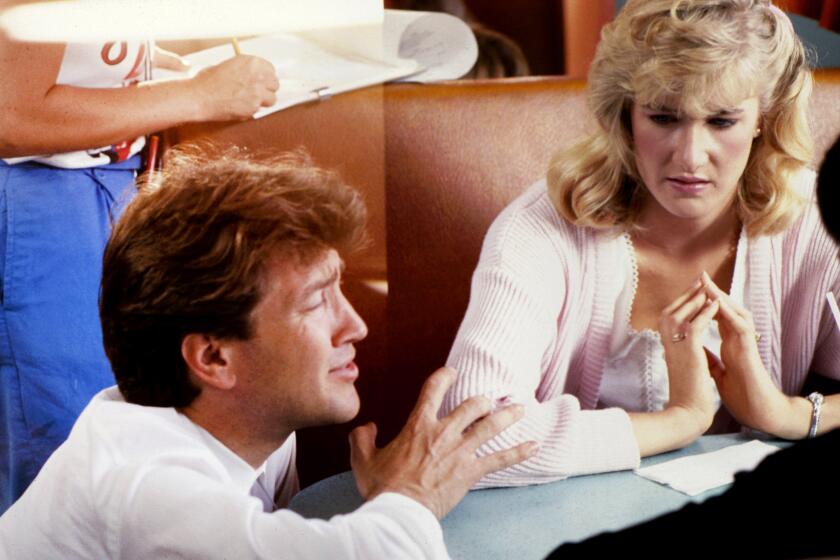Film Scouts: Eureka, They Have Found It!
- Share via
What’ll it be? A roadside diner? A swamp? A cornfield? A tobacco plantation? A Victorian house or a Cape Cod? The Petrified Forest? A row of tenements? Ohio? Michigan? A Swiss bank? A castle? Paris? London? Dusseldorf? West Podunk? Sleepy Hollow? Birnam Wood or Dunsinane hill?
California, which claims to be able to purvey all of the above and more for the silver screen, offers one reluctant demurrer:
Sorry, the New York City skyline is not available.
That galls the people who make a career out of aiding and abetting make-believe, who search and scour the Golden State to provide film makers with any backdrop they need.
Feature films are a $5-billion industry in the state, and in 1985 it lost just under $1 billion to other states, not counting films produced abroad. California is not pleased.
Richard Davis, a shortish, fast-talking 45-year-old who likes to sleep on weekends to make up for what he loses during the week, is a location scout and manager. Day and night, he has California on his mind.
As great and varied as the state is, Davis finds out early, “In making films, learning how to compromise is learning how to live.”
For instance, he says, “I’ve got a scene that says train station. Is it Union Station or something that we’re going to make look like a train station?”
The art director says Union Station. Davis researches the cost. He tells the production manager that the bill will be $5,000 a day plus $2,000 a day for additional insurance. He outlines possible problems. The production manager says, “Ouch! I have $2,000 in for that. Tell him to put it in a room somewhere and put up a sign that says ‘Union Station.’ ”
Later they may go back to Union Station, or change the whole thing to an airport.
Time Sometimes Short
Davis may start three months or three weeks before a film goes into production. Sometimes, when he starts early, locations he finds are so attractive they are worked into the script.
“They can change anything on you at any time and you have to be ready. And you have to smile when you do it.”
The one person who does not have to compromise is the director.
Davis came in late in the making of a film called “Eight Million Ways to Die,” a Robert Ludlum story directed by Hal Ashby. They started, says Davis, with “a wonderful Oliver Stone script that was going to cost too much to make.” It was set in New York, but they decided to do it in Los Angeles. At first they just tried substituting streets, Wilshire Boulevard for 5th Avenue, for example.
But then it became apparent that a lot of the locations just didn’t exist in Los Angeles. So while the script was being rewritten on the side, they worked off flash cards of scene concepts.
“We’d go to places to shoot for half a day and we’d be there five days. It was like a final exam in location managing. It was terrifying and interesting at the same time.”
Davis has worked on a slew of prestigious films and B films as well. He did the location work for “The Karate Kid,” “To Live and Die in L.A.,” “Ruthless People,” and “Against All Odds,” not to mention low-budget films like “Tough Turf” and “Crimes of Passion.”
There are two scales of pay for unionized location managers, $1,000 a week for those with less than three years experience and $1,400 for those with more.
Sometimes even that doesn’t seem like enough. Early in his career he was siting for a TV series pilot set in Zurich. He handled that so well, they asked him back, explaining that each week’s show would be set in a different major city in the world. Trouble was, the director said he didn’t want to film outside of a 10-square-mile area around his home. Davis smiled and said he’d take that into consideration when he gave his answer. “He went through something like 15 location managers on that series.”
The worst part of preproduction scouting, he says, is the “ND” or nondescript house. He gets some help from the art director on the size of rooms, the view. He pulls some file pictures from a locations agency (yes, houses have agents just like actors do), and he shows them around. If nothing looks right, he goes knocking door to door, to see if the insides are as satisfactory as the outsides promise. “Scouting bathrooms and backyards,” is what he calls it.
In production, he is responsible for keeping everyone happy at the location and being ready to move at the drop of a hat. He has to stay within budget, the last two of which have run between $150,000 and $200,000. There are all kinds of minor expenses.
“The fact you’re paying $1,000 a day for a nice house is quite deceptive. With everything else, your expenses might come to $4,000 a day.”
Just for the privilege of being there. There are permits from communities which run $1,500 a day in a place like Manhattan Beach, $600 a day in Beverly Hills or Pasadena or only $250 a day in some outlying communities.
Then you have to have a parking area for all of the trucks. You have to hire police for traffic control, security and sometimes firemen.
It’s sort of like managing a temporary town with the understanding they can strike the set at any given moment.
“We get to the Santa Monica pier on ‘Ruthless People.’ Unusual weather. We get fog in February. We’re waiting for the sunshine. The foghorns are blowing so we couldn’t take even if we could see. Some shots are canceled. It’s 10 a.m. and they say can we go out and get the chase scene somewhere with the helicopter.”
The time clocks are ticking and all of the expensive crew is making money and doing nothing. Davis calls his police department coordinator and asks if he can provide five men who can shoot from the hip at such and such a corner. The coordinator says he’ll call back. Davis calls the permit office and gets instant approval for running shots in traffic covered by a helicopter 500 feet above roof level. The police call back and confirm. By noon, they are shooting the chase scene.
There are all kinds of restrictions. In Pasadena, you can’t shoot past 10 p.m. The location manager makes all the deals with the homeowners and the property owners. He makes sure that a banged-up door is fixed or replaced. He sometimes takes the part of the location people against his own film crew.
Davis resigned once because a director willfully violated an agreement.
Most of the time he gets along. He’ll argue that they agreed to be out of a neighborhood by midnight, but the production people want to go on until 2 a.m. “I take a lot of heat and I try to work it out with the neighbors.”
These days, with the help of the California Film Office, which has the power of the governor behind it, they are finally able to make deals to film on some isolated freeways and divert traffic to surface roads. That is a fairly new development. But how do you film Los Angeles without freeways?
Things are also difficult because the communities in and around Los Angeles are a little blase about movies and a little tired of having the cinematic three-ring circus move into the neighborhood.
“You can go to Utah with Rod Steiger or Kathleen Turner and people are delighted. . . . You want to shoot from rooftops? Anything you want. In Los Angeles, it’s ‘Oh, no, you’re not going to park those trucks on my street.’ ”
Davis says you can find most everything in California and the Los Angeles area.
“You can go to the L.A. Arboretum and be in Malaysia. You can go downtown and be in New York. There are houses in Pasadena that look French, although if you want an entire French street circa 1910 that Marcel Proust would have walked, forget it. Medieval Russia would probably be hard to do too.”
At the California Film Office, the New York City skyline is irksome, says Lisa Rawlins, the brisk, bright 27-year-old who is director.
“I think New York City is the toughest obstacle we have, because New York just has the age and the buildings we don’t have,” Rawlins says. “If the show is written for New York, it’s very difficult to double it anywhere else.”
Nevertheless, “Cagney and Lacey” uses establishing shots of New York and shoots in downtown Los Angeles. Some other shows do too. Others that were written for New York are rewritten for San Francisco and Los Angeles.
Besides, Normandie Avenue tenements in the heart of Los Angeles have a nice Brooklyn look, she says.
Her job is to keep films in California. Of 175 feature films started in the United States in 1985, 59 were shot entirely in California and 35 were shot mostly in the state. She’d like to see that share increased. Television is less of a problem. Ninety-five percent of television production remains in the state, although New York has the lion’s share of the soaps.
“People talk about how easy it is to shoot in New York City. Free police. Free firemen. And the fact that the city is so accommodating. But there will always be hazards. . . . Traffic. It’s tough to get a crew cross town. And noise.”
Getting cross town can be a problem if you have to switch locations quickly as Richard Davis has to sometimes.
Flexibility is his stock-in-trade. Movie production, he says, “is like running as fast as you can ahead of a moving train. If you did your work well at the beginning, it only means you are ready for what is supposed to happen, not what’s going to happen.”
More to Read
Only good movies
Get the Indie Focus newsletter, Mark Olsen's weekly guide to the world of cinema.
You may occasionally receive promotional content from the Los Angeles Times.









